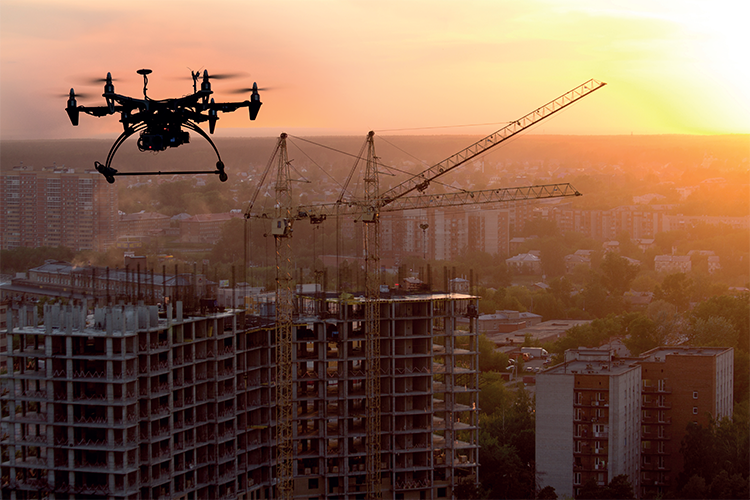
Future vision
As the world of technology and construction develops, we are edging closer to the future science fiction envisioned. We may not be gliding around on hoverboards quite yet, but if the construction industry is anything to go by, there are some breath-taking innovations on the horizon.
Smart technology, or ‘Self- Monitoring Analysis and Reporting Technology’, is currently transforming the construction industry and informing how we will live our lives for years to come. Built around connectivity and analytics, smart tech allows devices to link up with one another and share information, whether this is about the wearer, the location, or pretty much anything else. We’ve all become accustomed to smart technology in our day-to-day lives — where would we be without our mobile phones, our tablets, and our smartwatches? But as our cities and infrastructures grow, the construction industry is building smart technology into all walks of life.
From smart fridges to smart metropolises, let’s take a look at how smart technology is set to keep transforming our world and how the construction industry is utilising it.
Smart buildings
Imagine a building that could react to its residents, slightly alter itself to suit your every need, and do all this without even the flick of a switch. Smart technology has already made this possible. Within smart buildings, a specifically designed wearable device can transmit information to and from the building and make adjustments according to your needs.
Smart buildings are designed around the ideas of comfort and wellbeing, with a focus on peoples’ contentment. If, for example, you started to feel a little too hot, your wearable would transmit this message to the air conditioning system, and it would adjust the temperature for you.
However, there are complications to this design of course. For instance, how can one building react to the needs of each and every person within it?
One option is to take an average reading for each inhabitant and create a reactive ‘average’ atmosphere. Or alternatively, highly accurate sensors could be installed that are able to locate and react to specific individuals accurately.
Drones and AI
Drones and artificial intelligence are also set to play an integral part in the future of the construction industry. Drones are already being created to map construction sites, plan work, and guide autonomous vehicles such as cherry pickers around the worksite. In fact, it only takes drones around 15 minutes to scan a site and maps its terrain. In comparison, this job normally takes humans several days.
Smart technology works to share data collected by drones, from their bird’s eye view perspective, with the autonomous vehicles on the ground — which then allows the vehicles to act on their own, without the need for human intervention.
Smart cities
It doesn’t stop at buildings and certain construction sites — smart technology is set to transform entire cities, creating incredible webs of information and analytics everywhere. In a similar way to smart buildings, smart cities are designed to monitor systems and citizens while trying the improve the flow of the city, thereby improving general wellbeing.
Many cities across the globe are already turning to smart technology and experimenting with ways that they can improve traffic systems, energy usage, and public safety. Amsterdam, Boston, and Baltimore are three of the forerunners in smart infrastructure, which has so far proved helpful for many things, including ‘smart trashcans’ which can determine the most efficient route for sanitation workers.
These smart technology methods are also being tested on a smaller scale. University campuses, for example, often function as a micro-city would, and are therefore the perfect testing locations for smart city technology. Within a ‘smart campus’, each student’s smartwatch could alert them to their next class, make them aware of library books that need returning, keep you up to date with assignments, and much more.
The future for the construction industry is certainly bright and beginning to mirror everything sci-fi envisioned. Smart technology will allow our infrastructure to reach dizzying new heights, as we embrace a whole new ‘smart’ way of living.
Sources
https://www.designingbuildings.co.uk/wiki/The_future_of_ smart_buildings
https://www.forbes.com/sites/jamesellsmoor/2019/05/19/smart-cities-the-future-of-urban-development/#24a2917b2f90
https://www.technologyreview.com/2018/03/15/144645/ai-and-drones-are-being-used-to-control-construction-projects/
Amy Hodgetts is a copywriter at SMD. SMD is an advanced global designer and manufacturer of subsea remotely operated and autonomous power and control solutions. Operating across several technology areas, SMD specialises in subsea trenching, work class ROVs, submerged mining and vessel deck equipment, as well as providing a range of subsea components through the Curvetech brand. SMD Services offer the capability, resources and expertise to support clients in multiple operations; around the clock and on a global scale.
SMD has a passion for excellence, backed by proven engineering expertise and outstanding global service over the last 50 years.
https://www.smd.co.uk/